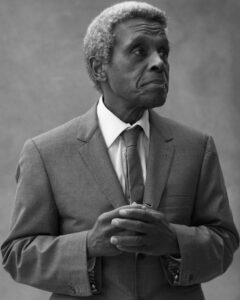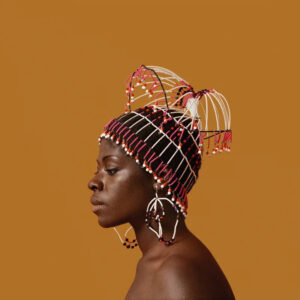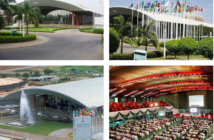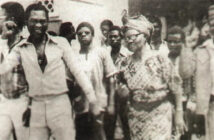
Kwame Brathwaite. Photo Credit: Cory Rice
The 1960’s ushered in several notable black civil activists from Martin Luther King (NAACP), Muhammad Ali and Malcom X. (Nation of Islam), Sam Cook, James Baldwin, Huey P. Newton and Fred Hampton (Black Panther), but few will be familiar with the name Kwame Brathwaite.
Kwame Brathwaite was a key figure in the 1960s “Black is Beautiful” movement. Brathwaite’s work emphasised Black power and beauty, from Nelson Mandela to Muhammad Ali and the so-called Grandassa Models. The Motown Revue at the Apollo in 1963, The Jackson 5’s first tour to Africa in 1974, and the fabled Foreman-Ali fight, The Rumble in the Jungle, were just a few of the events he covered.
Photographer Kwame Brathwaite passed away at his home on April 1st. Brathwaite’s death was announced by his son on Instagram.
“I am deeply saddened to share that my Baba, the patriarch of our family, our rock and my hero, has transitioned. Thank you for your love and support during this difficult time,” writes Kwame S. Brathwaite, who maintains his father’s archive.
Reknowned as a photographer and cultural activist Kwame Brathwaite was instrumental in spreading the word about black pride and empowerment in the United States during the 1960s and 1970s. Brathwaite, who was born in Brooklyn, New York, in 1938, was the oldest of an eight-child family. He became interested in photography at a young age and started taking images when he was a teenager.
Beginning in the 1950s, Brathwaite became heavily active in Black culture and politics after being inspired by Marcus Garvey, a Jamaican-born politician. He and his brother Elombe Brath helped organise performances in clubs in the Bronx and Harlem. Kwame took pictures of them. AJASS, the African Jazz Art Society & Studio, was founded with their assistance.

Kwame Brathwaite, Sikolo Brathwaite, African Jazz-Art Society & Studios (AJASS), Harlem, ca. 1968; from Kwame Brathwaite: Black Is Beautiful (Aperture, 2019).
Kwame Brathwaite/Philip Martin Gallery, Los Angeles / Aperture
Ronald Brathwaite was born in 1938 in Harlem to Barbados-born parents. When he was five, the family relocated to the Bronx. His father ran dry cleaning shops in addition to being a tailor. His mother operated a catering business out of their house.
Carlos Cooks, the creator of the African Nationalist Pioneer Movement, developed the word “Grandassa,” was the inspiration for Brathwaite’s series of images of Grandassaland Models. The purpose was to encourage Black women to accept their African roots rather than strive to style their hair like white women to look like them.
According to Brathwaite, “We said, ‘We’ve got to do something to make the women feel proud of their hair, happy of their blackness.”
Early on in the 1960s, Brathwaite joined the African Jazz Arts Society and Studios (AJASS), a group of artists and activists working to advance a positive perception of black identity and culture. In order to capture the passion and energy of the black community in New York City, Brathwaite started taking pictures of the group’s activities and concerts.
Brathwaite co-founded the Grandassa Models in 1962, an all-black modelling team that questioned the prevailing beauty norms of the day. The group’s goal was to promote the diversity and complexity of black culture while also celebrating black beauty and pride. With their natural haircuts and attire with African influences, Brathwaite’s images of the Grandassa Models helped redefine beauty in America and laid the groundwork for the Black is Beautiful movement of the 1960s and 1970s.
Over the course of the 1960s and 1970s, Brathwaite continued to work as a photographer and cultural activist. Important turning points in the civil rights movement, including as the 1963 March on Washington and the 1968 Poor People’s Campaign, were captured on film by him. By capturing the beauty and grit of black men and women in his pictures, he also continued to use photography to spread the message of black pride and empowerment.
The popularity and admiration for Brathwaite’s work has recently increased. The Aperture Foundation in New York City hosted a retrospective of his images in 2019 that highlighted his contributions to the Black is Beautiful movement and his lasting impact as a photographer and cultural activist.
Kwame Brathwaite’s life and work serve as a testament to both the value of honouring and supporting many cultural identities as well as the ability of art to affect societal change.
Reflecting on his time, Braithwaite told Vogue, “My goal was always to capture the beauty of black women, to restore black pride and the spirit of black women.”

Kwame Brathwaite, Sikolo Brathwaite wearing a headpiece designed by Carolee Prince, African Jazz-Art Society & Studios (AJASS), Harlem, ca. 1968; from Kwame Brathwaite: Black Is Beautiful (Aperture, 2019)
Kwame Brathwaite/Philip Martin Gallery, Los Angeles / Aperture




